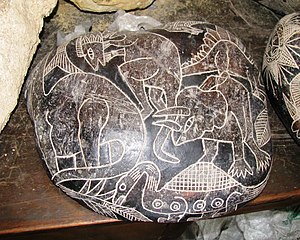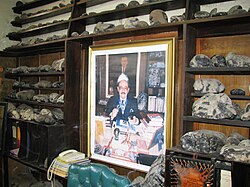Ica stones

The Ica stones are a collection of andesite stones found in or near Ica, Peru that bear a variety of diagrams. Some of them apparently have depictions of dinosaurs and what is alleged to be advanced technology, and these are not considered to be genuine archeological artifacts but instead were recently created by local people as curiosities or hoaxes.
Description
The stones are composed of andesite and vary in size from pebbles to boulders. They are shallowly engraved with a variety of images, purportedly depicting a variety of scenes:[1][2]
- extinct animals, such as dinosaurs
- advanced medical works
- maps
Popularization by Cabrera

In 1966, Peruvian physician Javier Cabrera Darquea was presented with a stone that had a carved picture of what Cabrera believed to be an extinct fish by a friend for his 42nd birthday.[3] Cabrera's father had begun a collection of similar stones in the 1930s, and based on his interest in Peruvian prehistory, Cabrera began collecting more. He initially purchased more than 300 from the Soldi brothers who also collected pre-Incan artifacts, who claimed they had unsuccessfully attempted to interest archaeologists in them. However, archaeologist Alejandro Pezzia Asserto, who was in charge of archaeological investigations in the cultural province of Ica conducted official excavations in the ancient Paracas and Ica cemeteries of Max Uhle and Toma Luz. On two separate occasions engraved stones were excavated from Pre-Hispanic Indian tombs dating from 400B.C to 700A.D The engraved stones were embedded in the side of the mortuary chamber of the tombs next to the mummies. Cabrera later found another source of the stones, a farmer named Basilio Uschuya, who sold him thousands more. Although Basilio does actually Make Ica Stones and sell them to tourists, the original ones he found buried in his fields have not been show to be forgeries.[4] Cabrera's collection burgeoned, reaching more than 11,000 stones in the 1970s.[2] Cabrera published a book, The Message of the Engraved Stones of Ica on the subject, discussing his theories of the origins and meaning of the stones. In this he argued that the stones show "that man is at least 405 million years old" and that what he calls gliptolithic man, humans from another planet, and that "Through the transplantation of cognitive codes to highly intelligent primates, the men from outer space created new men on earth." [5] The Ica stones achieved greater popular interest when Cabrera abandoned his medical career and opened a museum to feature several thousand of the stones in 1996.[1]
In 1973 during an interview with Erich von Däniken, Uschuya stated he had faked the stones that he had sold.[2] In 1975 Uschuya and another farmer named Irma Gutierrez de Aparcana confirmed that they had forged the stones they gave to Cabrera by copying the images from comic books, text books and magazines. Cabrera questioned how it was possible for one farmer to create eleven thousand intricately carved stones. [1] Later Uschuya recanted the forging story during an interview with a German journalist, saying that he had claimed they were a hoax to avoid imprisonment for selling archaeological artifacts. In 1977, during the BBC documentary Pathway to the Gods, Uschuya produced an Ica stone with a dentist's drill and claimed to have produced the patina by baking the stone in cow dung.[2] That same year, another BBC documentary was released with a skeptical analysis of Cabrera's stones, and the newfound attention to the phenomenon prompted Peruvian authorities to arrest Uschuya, as Peruvian law prohibits the sale of archaeological discoveries. Uschuya recanted his claim that he had found them and instead admitted they were hoaxes, saying "Making these stones is easier than farming the land." He engraved the stones using images in books and magazines as examples and knives, chisels and a dental drill.[6] He also said that he had not made all the stones. He was not punished, and continued to sell similar stones to tourists as trinkets.[2] The stones continued to be made and carved by other artists as forgeries of the original stones.[1]
Impact
The stones have been used by some creationists attempting to show evidence of humans living in proximity with dinosaurs[2], a claim for which no evidence exists[7] and that contradicts the well established evidence that the extinction of dinosaurs predates mankind by approximately 65 million years.[8] Believers in ancient astronauts have also attempted to use the stones as evidence of a lost, advanced civilization brought to man from other planets[2] and mytho-historians have claimed them as evidence that ancient myths are accurate histories, neither of which are positions supported in the scientific or academic communities.[1]
In his Encyclopedia of Dubious Archaeology: From Atlantis To The Walam Olum archaeologist Ken Feder commented "The Ica Stones are not the most sophisticated of the archaeological hoaxes discussed in this book, but they certainly rank up there as the most preposterous."[9]
See also
Footnotes
- ^ a b c d e Carroll, Robert T. (2003). The Skeptic's Dictionary: a collection of strange beliefs, amusing deceptions, and dangerous delusions. New York: Wiley. pp. 169–71. ISBN 0-471-27242-6., also online at skepdic
- ^ a b c d e f g Coppens, P (2001). "Jurassic library - The Ica Stones". Fortean Times.
{{cite journal}}: Unknown parameter|month=ignored (help) Available without registration at philipcoppens.com - ^ Cabrera, Javier. The Message of the Stones. Ica, Peru. Retrieved 12-05-10.
{{cite book}}: Check date values in:|accessdate=(help) - ^ Alejandro Pezzia Asserto. Ica Y el Peru Precolombino. Volume 1 (Ica:1968), P. 25ff.
- ^ Cabrera, Javier (2000). The message of the engraved stones of Ica.
- ^ Kenneth L. Feder, Encyclopedia of Dubious Archaeology: From Atlantis To The Walam Olum, pages 143 (Greenwood, 2010). ISBN 978-0-313-37919-2
- ^ "Claim CH710:". Talk.origins. Retrieved April 17, 2012.
- ^ "When Did Dinosaurs Go Extinct? Cretaceous-Tertiary Boundary Dating Refined". Science Daily. Retrieved April 17, 2012.
- ^ Kenneth L. Feder, Encyclopedia of Dubious Archaeology: From Atlantis To The Walam Olum, pages 270-271 (Greenwood, 2010). ISBN 978-0-313-37919-2
External links
- Images of the Ica stones
- Theory post-Cabrera - articles on the Ica Stones, the Global Elite, the Pleiadians, etc.
- Ica stones at the Pseudoarcheology Research Archive
